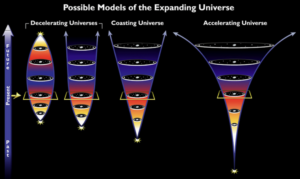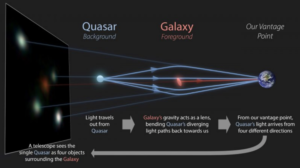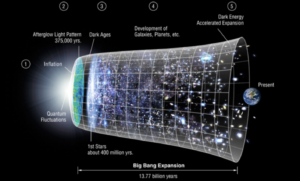Hidden Matter: The Lambda CDM Model of Our Universe
Written by: Maneth Perera
The vast amounts of empty space between stars may not be so empty after all. Dark matter is a theorized invisible substance that fills in these gaps, and it’s discussed extensively in the Lambda Cold Dark Matter Model (ΛCDM for short) model. With new theories and models for cosmological events appearing every day, the ΛCDM is one of the most well-standing and respected theories. Using the ΛCDM’s establishment of dark matter, dark energy, and cosmological constants, certain galactic events can be explained properly whilst abiding by the rules of general and special relativity.
Push and Pull of the Universe
Gravity is one of the four fundamental forces of the universe. Gravity is what curves spacetime (making light that travels through space change course) and causes an attractive force between objects. It is found everywhere there is matter, so wouldn’t the force of gravity be slowing the expansion of the universe? The inner objects should be able to exert a gravitational pull on the edges of the universe and stop its expansion, but this isn’t the case. In fact, the movement of stars suggests that the expansion of the universe is speeding up, seeing how the distance between stars is increasing exponentially.
How does the expansion of the universe apply to the ΛCDM model? Well, a key part of the model is dark energy, a theoretical, invisible force that pushes the universe outwards, counteracting gravity and accelerating the expansion of the universe. While dark energy is what pushes galaxies apart, dark matter is what keeps galaxies together. The gravitational force to keep solar systems together inside galaxies isn’t enough, so it’s theorized that invisible dark matter inside of these galaxies is what provides the extra gravity needed to keep the galaxy from collapsing. The ΛCDM can account for these astronomical flaws easily using dark matter and dark energy interactions together.
Figure 1

Diagrams showing different possible models for the expansion of the universe.
Source: National Aeronautics and Space Administration and European Space Agency
What is Dark Matter?
What really is dark matter? Dark matter is, by definition, simply any matter that doesn’t interact with electromagnetic (EM) waves. Most matter on Earth interacts with the visible light spectrum as well as EM waves of other frequencies. Dark matter is special in that it doesn’t interact with any EM energy at all—making it completely undetectable with most common telescopes.
The reason for the prediction of such an entity is due to multiple phenomena only being explainable by having more matter in an area than there seems to be. More matter means more gravity and therefore an unaccounted for increase in the forces moving objects around. Gravitational lensing is the bending of light (and other EM waves) around stellar objects that changes their trajectory. Sometimes, if an object is blocking the path between Earth and another object that is emitting light, the light can bend around due to the blocking object’s curvature of spacetime. When this bending is more than the calculated curve of the blocking object, the extra mass can be accounted for by a pervasive invisible mass. Extra mass problems arise in star formation as well, as extra mass seems to build up in protostars (clouds of gas that are slowly forming into a star) even when no perceived objects are being pulled in.
Dark matter fits neatly into multiple mathematical models of the universe, causing it to become a widely accepted theory. The ΛCDM model, however, expands upon this with the concept of dark energy as well.
Figure 2

A depiction of gravitational lensing with a quasar, EM wave-emitting blackholes, and the result—one quasar is seen as four light-emitting objects from Earth.
Source: Kelly Kizer Whitt of EarthSky
Main Parameters of the Model
The main parameters of the ΛCDM model are the existence of dark matter, the existence of dark energy, the cosmological constant (the energy density of space, related to dark energy), and the interactions they have with normal matter.
There are a few types of dark matter that are postulated in different theories, but the ΛCDM model deals with the most common type: cold dark matter. Cold dark matter is matter that is non-baryonic (not made out of protons, neutrons, and electrons like ordinary matter) and cold (can’t reach the speed of light at maximum radiation absorption). Along with this, cold dark matter is also dissipationless (can’t release photons) and collisionless (only uses gravity and the weak force to interact with other particles). These aspects of cold dark matter allow it to affect certain aspects of astronomical objects without interacting with other matter too much.
By assuming Einstein’s model of general relativity applies to all objects in the universe, even the large-scale and small-scale ones, the ΛCDM model can use cosmological equations of state. This allows the model to drastically simplify force interactions and certain field equations whilst maintaining good explanations for many astronomical events.
Main Drawbacks of the Model
The ΛCDM model doesn’t justify all astronomical events, though. Certain galaxies have density distributions that can’t be explained with dark matter but still act as if they do have added mass. The ΛCDM model predicts that there is a much larger number of dwarf (small) galaxies than there actually are in the observable universe (the part of the universe we can see with our current telescopes). It also can’t predict the erratic movement of these dwarf galaxies using dark energy. Many other problems arise when trying to apply the ΛCDM model to special galaxies that interact with the universe in unusual manners. Other models such as entropic gravity, bimetric gravity, or modified gravity models account for fluctuations in the way gravity works for smaller/larger galaxies. However, these same models can’t account for specific aspects such as universal expansion like the ΛCDM can. Because of this, some sort of middle-ground model between them is needed.
Figure 3

A diagram of the increase in dark energy as the universe rapidly expands after the Big Bang.
Source: NASA Goddard Space Flight Center – WMAP Science Team
Conclusion
The Lambda Cold Dark Matter model is a great tool for cosmologists and astrophysicists to create mathematical models explaining certain stellar phenomena, but it still has a long way to go. Every day, new observations are being made and new theories are popping up about the unknown substances and celestial objects in our universe. The ΛCDM is obviously being adjusted and updated every day, but eventually, it will be replaced by a better model. In reality, all models will be replaced eventually as we learn more and more about the universe around us.
References and Sources
Bolles, D. (2023, June). Dark Energy, Dark Matter. NASA Science. https://science.nasa.gov/astrophysics/focus-areas/what-is-dark-energy/
CERN. (n.d.). Dark Matter. CERN Accelerating Science. https://home.cern/science/physics/dark-matter
The Dark Energy Survey. (2019, March 11). Overview. The Dark Energy Survey. https://www.darkenergysurvey.org/the-des-project/overview/
Harvard & Smithsonian. (n.d.). Dark Energy and Dark Matter. Center for Astrophysics. https://www.cfa.harvard.edu/research/topic/dark-energy-and-dark-matter
National Aeronautics and Space Administration. (2022, September 30). Dark Energy. Hubblesite. https://hubblesite.org/contents/articles/dark-energy
6 thoughts on “Hidden Matter: The Lambda CDM Model of Our Universe”